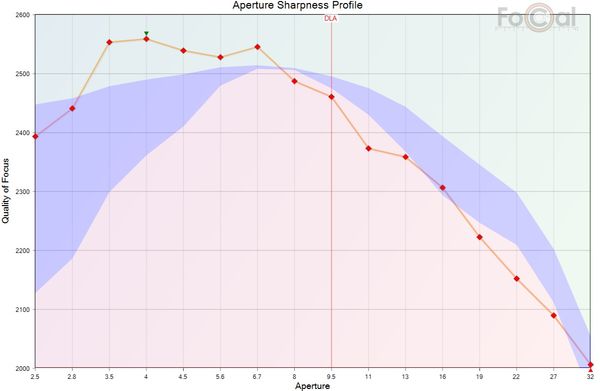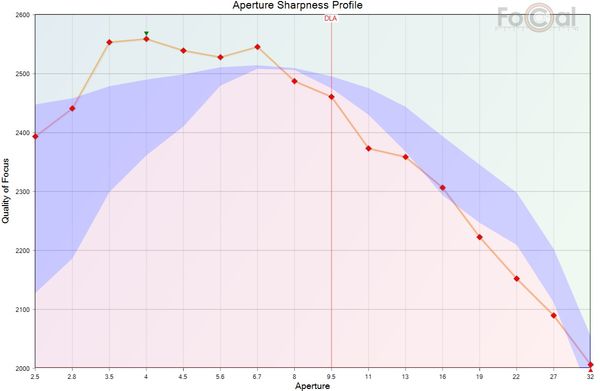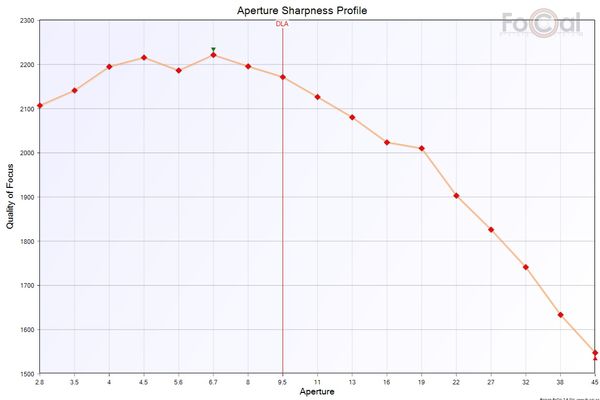Macro Question
Jan 3, 2021 14:59:20 #
John Maher wrote:
How do I determine "sweet spot"
I am considering stacking and centering on the "sweet spot" makes sense.
I am using an AIS Micro-Nikkor 105mm which has aperture of f4 to f32.
I would like to understand how to determine "sweet spot", not just what the "sweet spot" is for this lens.
I am considering stacking and centering on the "sweet spot" makes sense.
I am using an AIS Micro-Nikkor 105mm which has aperture of f4 to f32.
I would like to understand how to determine "sweet spot", not just what the "sweet spot" is for this lens.
If you look at that site Gene posted you can see how a lens tests at different f stops in different areas of the lens. Diffraction is usually a gradual reduction in quality as f stop gets smaller, but there are other factors. Chromatic aberration usually happens more wide open. So many lenses will look best one stop from wide open, but some are very even across many f stops.
Jan 3, 2021 20:12:33 #
A
👍👍 Exactly. I think many underestimate the effect of diffraction on sharpness at small apertures. Having measured it, I know that you can easily lose 20% or more by f32 depending on the lens - the difference between good glass and a cheap lens. I almost never go beyond f11 (and prefer not to go beyond f8) on a FF unless I REALLY have no other choice. Just as an example, here’s a fairly sharp 50mm f2.5 macro
Gene51 wrote:
Yes, I get fine detail at F16, but I get better an... (show quote)
👍👍 Exactly. I think many underestimate the effect of diffraction on sharpness at small apertures. Having measured it, I know that you can easily lose 20% or more by f32 depending on the lens - the difference between good glass and a cheap lens. I almost never go beyond f11 (and prefer not to go beyond f8) on a FF unless I REALLY have no other choice. Just as an example, here’s a fairly sharp 50mm f2.5 macro

Jan 3, 2021 21:28:34 #
bleirer wrote:
If you look at that site Gene posted you can see how a lens tests at different f stops in different areas of the lens. Diffraction is usually a gradual reduction in quality as f stop gets smaller, but there are other factors. Chromatic aberration usually happens more wide open. So many lenses will look best one stop from wide open, but some are very even across many f stops.
It is also not uncommon for slower lenses to have less CA, while the usually more expensive fast lenses F1.2, F1.4, F1.8 etc are noticeably worse.
Jan 3, 2021 22:16:02 #
carney2 wrote:
I have a macro lens that will get me to f/32, so I go for maximum depth of field and add needed light via a flash or a reflector.
Opinions?
Opinions?
If you are personally happy with the loss of IQ due to diffraction in the finished results no reason not to use such a small aperture.
Jan 3, 2021 22:20:40 #
I use a hasselblad bellows with a hasselblad lens for macro and get great results
Jan 3, 2021 23:08:55 #
carney2 wrote:
100 mm
100mm. Excellent !!!
UHH is full of maniac theoreticians but there is no actual need to use the lens’s absolute very best f/stop. OTOH, staying clear of truly too small an aperture is often advisable. But there’s no f/45 on your lens anywho.
With your 100mm lens, f/32 is the same size physical hole as f/16 with a 50mm. With a 50mm, f/8 and f/11 are generally considered ideal, which means f/16 can start to show some loss. That f/16 on the 50mm equates to the same size hole as f/32 on your 100mm.
So your f/32 is barely at the boundary of territory to avoid. “Barely the boundary” is worth avoiding when possible, but is not really any problem for most subjects. The gain in DoF is often worth more than a minor loss to diffraction.
UHH geeks love to speak of detail, detail captured or lost. But the perception of sharpness is not dependent on detail. It is mainly dependent on edge sharpness (aka accutance).
Acoarst, an edge is a sort of detail in itself. Local contrast also creates sharp looking edges. And a SMALL amount of sharpening in post can enhance that. Telling the geeks to “get real” is just whistling into the wind. But you can ignore them and individually get real.
Do what makes your pix look great and don’t be in fear of theory. Theory can be readily proven, but is not readily seen ... in real world pix.
Google “resolution accutance sharpness photo review”. Very clear and easy to read article in “Photo Review”.
Jan 4, 2021 00:44:17 #
User ID wrote:
100mm. Excellent !!! br br UHH is full of maniac ... (show quote)
I believe we have had this discussion before, and again we will have to agree to disagree. “Sharpness” is a function of resolution, acuity and contrast, and as you can clearly see from the graph above the difference between f11 and f32 is approximately 15% on this 50mm Macro. On the next graph of a 100mm f2.8 lens, the difference is also approximately a loss of 15% in acuity from f11 to f32 - so much for the idea that diffraction is less of an issue on longer or shorter FLs in practical terms. Since that 15% is roughly the difference between a first rate lens and a mediocre one, it’s unclear to me why one would buy a $800 lens and then adjust it to the performance in terms of acuity to that of. $300 lens, but if your explanation is that acuity doesn’t matter, then you should be able to save lots of money on lenses. Interesting that pros and at least one very accomplished photographer here who exhibits excellent work regularly aren’t interested in adopting that approach.
Now if DOF, let’s see what is gained. On a FF, 50mm Macro at 1’ and f11 has a depth of field of .84”, at f16, it is 1.2”, and at f32, it is 2.4”. That may or may not be significant to the OP, but like everything else in photography, there is a compromise, but it’s not necessary in all cases. If the subject is stationary, by taking multiple shots and focus stacking, you can have the acuity AND DOF - something to consider.


Jan 4, 2021 05:52:26 #
billnikon
Loc: Pennsylvania/Ohio/Florida/Maui/Oregon/Vermont
carney2 wrote:
Due to being stuck in one place because of the vir... (show quote)
https://expertphotography.com/difference-between-macro-micro-and-close-up-photography/#:~:text=Macro%20means%20you're%20taking,see%20with%20your%20naked%20eye.
Or.
Macro means you're taking super close-ups of objects at 1:1. Meaning, the size of the image on your sensor is equal to the size of the item you're photographing in real life. Micro means the magnification is at a microscopic level. In other words, it deals with subjects you can't see with your naked eye.
Jan 4, 2021 06:40:45 #
bleirer wrote:
I think one reason for stacking is fear of diffraction. With stacking you get to use the sweet spot of the lens.
I think it is called macro is because it means 'large.' With magnification at 1x or better the image on the sensor is as big or bigger than the object in the world.
I think it is called macro is because it means 'large.' With magnification at 1x or better the image on the sensor is as big or bigger than the object in the world.
Correct!

Jan 4, 2021 06:56:57 #
Leitz
Loc: Solms
carney2 wrote:
Due to being stuck in one place because of the vir... (show quote)
Depending upon how sharp your lens is to begin with, and the end use of the image, a 20% loss of sharpness can be piddling. Much ado about not much.
Jan 4, 2021 07:00:45 #
Gene51 wrote:
Thanks!
But the mantis was a focus stacked image comprised of 13 images. It's sharp because I didn't rely on a small aperture for DoF.
Here is one of the component images:
.
But the mantis was a focus stacked image comprised of 13 images. It's sharp because I didn't rely on a small aperture for DoF.
Here is one of the component images:
.
WOW - huge difference between the focus stacked image and one of its composites. Nice job !!
Jan 4, 2021 07:59:01 #
tcthome
Loc: NJ
If you don't want to do the stack thing, maybe close-up photography will be more to your liking. What subjects do you like to shoot.
Jan 4, 2021 08:23:39 #
Jan 4, 2021 08:44:06 #
Gene51 wrote:
I think the aperture decision is more than just the need for depth of field - image size, possibility of movement, how much detail you want to capture, and the unique capabilities of a lens all go into the decision.

 All these decisions will define you and your vision/subject interpretations as a photographer -
All these decisions will define you and your vision/subject interpretations as a photographer - .
Jan 4, 2021 08:47:21 #
carney2 wrote:
Due to being stuck in one place because of the vir... (show quote)
I think if you tried it and used software other than PS, such as Zerene or Helicon, you would find it much easier than you think, and the results can be spectacular.
If you want to reply, then register here. Registration is free and your account is created instantly, so you can post right away.






